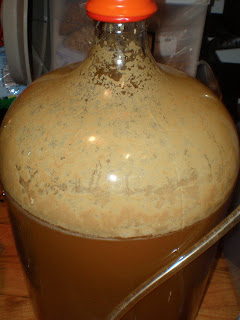Today I decided to brew 2 beers. A Wit and an American IPA. The wit beer is my fiances favorite so i always have to have it in the inventory. I started on the wit early, around 7am. I based it on recipe I have brewed only once before. I thought that the beer was a little too bitter so I changed the hop schedule. Instead of Belgian pils I used American 2 row, no reason, just because I had it in my grain stock.
Wit Beer:5lbs American 2-row3lbs White Wheat1/2lb Belgian Aromatic1/2lb Cara-Pils1.5lbs Flaked Wheat1/2lb Rice Hulls1/2oz Willamette (4.6% AA) 60min1/2oz German Spalt 15min3/4oz Sweet Orange Peel 15min1tsp Crushed Coriander 15min1/4oz Sweet Orange Peel 1min1/2 tsp Crushed Coriander 1minI heated the strike water to 172, threw it in the mash tun to preheat. Once the temp was at 163 I doughed in. Mash stabilized at 152. I let it rest for 90min. I sparged with 4.5gal, and collected 6.5gal with an OG of 1.036. for a 65% efficiency. Not exactly what I was shooting for but I did increase efficiency by 10 points from the last session. When I rack this to secondary I will taste and decide how much, if any, dry hopping I will do.
On to the next one. This
"Don't Call It A Come Back" IPA is a recipe that I threw together with what I had in my grain stock. I had an assistant to help with this batch, which was nice. The last brew session was supposed to be an IPA but because my efficiency was so low the OG was too low to call it an IPA, so viola, Pale Ale! This time I went for more grains, more hops, and more hops, and did I mention more hops.
"Don't Call it a Comeback IPA"10lbs American 2-row2.5lbs Belgian Pils1/2lb Munich1/2lb caramel 201/2lbs UK Crystal 601/4lb Belgian Biscuit1oz Chinook (12.4% AA) 90min1/2oz Perle (7.9% AA) 30min1/4oz Chinook (12.4% AA) 30min1/2oz Cascade 15 min1/2oz Cascade 1min1oz Cascade (dry hop)1tsp Irish Moss 15minI striked with a little under 4.5 gal of water, and doughed in at 162 degrees. Did A sach. rest for 90 min and sparged with 4.75 gal. Collected 7 gallons of wort and boiled for 90 min. got and OG of 1.058 for a 70% efficiency. Much better then the morning brew session, a great way to end the day.


























+Lable+flat2.jpg)







